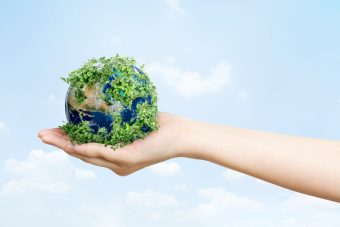
The last year has been a hard one for the planet. The Earth sweltered under record heat, nature continued its precipitous decline and pollution continued to claim millions of lives.
But amid all that, there is reason for hope, say those on the frontlines of the effort to create a more sustainable world.
In 2023, countries came together in unprecedented ways to tackle the triple planetary crisis of climate change, nature and biodiversity loss, and pollution and waste. This environmental multilateralism led to landmark pacts to end chemical pollution and transition the world away from fossil fuels, among a host of other milestones, many of which were supported by the United Nations Environment Programme (UNEP).
As the calendar turns to 2024, here is a closer look at the biggest environmental moments of the last year and what they mean for the future of the planet.
Study finds ozone layer “on track” for recovery
January
The ozone layer, which protects the Earth from ultraviolet radiation, is on track to recover within the next four decades, revealed a report from several scientific organizations, including UNEP. The Scientific Assessment of Ozone Depletion – 2022 found the planet’s sun shield could reach 1980 values over Antarctica by 2066 and over the Arctic by 2045.
Experts attributed the rebound to the Montreal Protocol, a planet-wide agreement adopted in 1987 to phase out many ozone-depleting chemicals. A 2016 amendment is also helping to rein in a series of powerful greenhouse gases and could avoid up to 0.5°C of global warming by 2100, the report found.
More:
- ARCTIC REPORT CARD DOCUMENTS EVIDENCE OF ACCELERATING CLIMATE CHANGE
- NEW WIND CHARTER AND NATIONAL WIND PLEDGES UNDERLINE AMBITION FOR WIND POWER IN EUROPE
- ARTIFICIAL INTELLIGENCE IMPROVES THE EFFICIENCY OF ELECTRIC VEHICLES
Fight for climate justice gains steam
February
The United Nations General Assembly adopted a resolution that many advocates hailed as an important step in the campaign for climate justice.
Spearheaded by the cyclone-wracked nation of Vanuatu, the resolution asks the International Court of Justice for an opinion on whether countries have a legal duty to address climate change and what the legal consequences of climate inaction could be. Experts say the court’s opinion, which is pending, would not be legally binding but would carry moral authority and some legal weight.
The resolution came as a growing number of people around the world turned to courts to compel governments and businesses to act on climate change. A UNEP study, released later in the year, found climate-related lawsuits have more than doubled since 2017.
Nations band together to protect freshwater sources

March
UNEP and several partners launched the Freshwater Challenge, which aims to safeguard and revive 300,000km of rivers and 350 million hectares of wetlands around the world by 2030. That would make it the largest wetland and river restoration effort in history. Some 43 nations joined the push in 2023, including many at the United Nations Climate Change Conference (COP28), whose presidency cited the Freshwater Challenge as a key outcome of the summit. Sources of freshwater are under increasing pressure from climate change, pollution and other stressors. One-third of the world’s wetlands have been lost over the past 50 years, while rivers and lakes are the most degraded ecosystems in the world.
World marks inaugural International Day of Zero Waste
April
Countries around the world celebrated the first International Day of Zero Waste, a global call for humanity to better manage waste and build more circular economies.
The day was led by UNEP and UN Habitat with support from Türkiye, and featured an address from UN Secretary General António Guterres. “Humanity is treating our planet like a garbage dump,” he warned. “It’s time to fight back and launch a war on waste.”
More than two billion tonnes of municipal solid waste is generated annually, of which 45 per cent is mismanaged. Up to 4 billion people lack access to controlled waste disposal facilities.
Creative solutions to plastic pollution abound at World Environment Day

June
UNEP-led World Environment Day, celebrated on 5 June, showcased to the world the scale of the plastic pollution crisis while highlighting a bevy of potential solutions. Several governments made firm commitments on the day, with host Côte d’Ivoire unveiling a new environmental code to fight plastic pollution and the Kyrgyz Republic announcing it will begin to transition away from some plastic products. The day grabbed the globe’s attention; it was the top-trending hashtag on Twitter and related content was seen more than 300 million times across social media.
Historic “high seas” treaty throws a lifeline to marine biodiversity
June
The United Nations formally adopted a pact that extends for the first time environmental protections to two-thirds of the ocean that lie beyond national jurisdictions.
The so-called “high seas treaty” offers an updated framework to The UN Convention on the Law of the Sea that came into force in 1994. The world’s oceans, which play a vital role in everything from the global economy to regulating the climate, are labouring under climate change, biodiversity loss and pollution.
“You have pumped new life and hope to give the ocean a fighting chance”, António Guterres, Secretary-General of the United Nations, told countries as the measure was adopted.
Global plastics instrument takes crucial step forward
September
The Intergovernmental Negotiating Committee on Plastic Pollution, hosted by UNEP, released a zero draft of a legally binding global instrument to end plastic pollution. The draft, which covers the full lifecycle of plastic, was reviewed during the third session (INC-3) in Nairobi, Kenya in November 2023. The talks in Nairobi followed a second session in Paris, France in June 2023. The INC sessions mark a key step in the effort to finalize a planet-wide agreement by the end of 2024.
Every year, humanity produces around 430 million metric tonnes of plastic – about the same weight as 71 million African elephants – and much of that is contained in single-use products that quickly become waste, polluting land, sea and air.
The rest of the text, read it here
Source: UNEP



